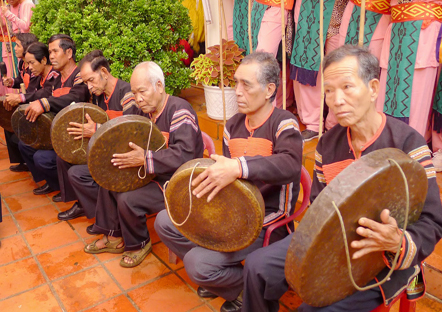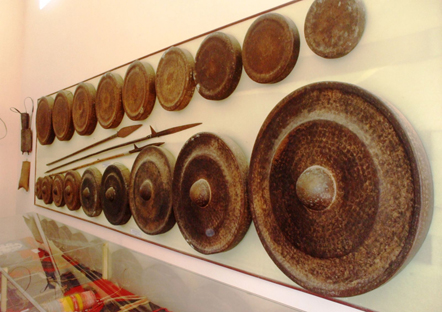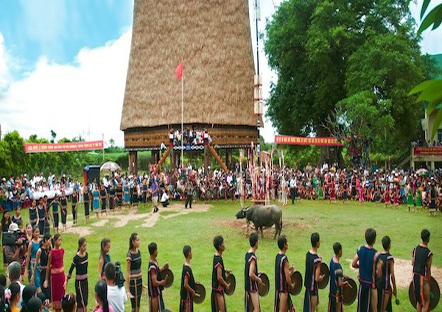Space of gong culture - masterpiece of the Intangible Heritage in Vietnam.
Published: 17/03/2017 09:53
The space of gong culture in the Vietnam Highlands is home to cultures that value gongs. It spreads in the Central Highland provinces of Kon Tum, Gia Lai, Dak Lak, Dak Nong, and Lam Dong. Together with "Nha nhac of Hue court", space of gong culture was recognized as a Masterpiece of the Intangible Heritage by UNESCO in 2005.
The gong culture sees gongs as a privileged connection between man and the supernatural where each gong hoses a deity whose power corresponds to the gong's age. It has been strongly affected by economic and social transformations that disrupted the traditional transfer of knowledge and stripped the gongs of their spiritual significance.
The Central Highlands gong culture emerged from long-standing cultural and historical traditions of ethnic communities living in the region, illustrating talented cultural creativeness of ethnic minorities, it is also level to other masterpieces of human creativity. The ethnic groups in this region have obtained thorough understanding and techniques of gong usage in their culture and music. As for ethnic minorities, gongs and gong culture present a means to affirm the community and its cultural identities. As time went by, gongs have become an attractive and appealing symbol of the culture of the Central Highlands. The space of gong culture in Central Highlands of Vietnam cover 5 provinces of Kon Tum, Gia Lai, Dak Lak, Dak Nong and Lam Dong. The master of gong culture are the ethnic groups of Bahnar, Brau, Chu Ru, K'Ho, E De, Gia Rai, Gie-Trieng, Ma, M'nong, Ro Mam, Xo Dang, Bru-Van Kieu, Ta Oi, Hre, X'tieng and Co Tu. The gong performances are always closely tied to community cultural rituals and ceremonies of the ethnic groups. Many researchers have classified gong as ceremonial musical instrument and the gong sounds as a means to communicate with deities and gods.
Nowadays, most of gongs are made from alloy of copper, zinc and lead. Gongs come in a variety of shapes and sizes: cồng have a nipple and produce a single, uniform sound, while chiêng are flat and offer a wider range of notes. Different sized gongs are characterized by names such as Mother, Father, Older sister and so on. Resting on the thigh or hanging from a frame, gongs can be drummed by hand or with a cloth-covered stick. The space of gong culture comprises parts such as gongs, song played with gongs, gong players, festivals using gongs (New rice celebration festival, water wharf worshipping ceremony,...), festival locations (long house, communal house, fields, wharf, funeral house, forests next to Tay Nguyen villages,..), etc.
At present, in gongs regions like Tay Nguyen, Gong Festival is held annually, it is considered as an activity bringing not only cultural characteristic but also an attractive tourism product. |
Provide by Vietnam Travel
Space of gong culture - masterpiece of the Intangible Cultural Heritage in Vietnam. - Oral and Intangible Cultural Heritage of Humanity | vietnam travel company
You can see more
enews & updates
Sign up to receive breaking news as well as receive other site updates!
- Banh Đa Cua - a traditional Hai Phong specialty
- Exploring Lai Chau cuisine
- Hanoi ranked top 3 cuisine in the world in 2023
- Beautiful resorts for a weekend escape close to Hanoi
- Travel trends in 2023
- In the spring, Moc Chau is covered in plum blossoms.
- The Most Wonderful Destinations In Sapa
- Top 3 Special festivals in Vietnam during Tet holiday - 2023
- 5 tourist hotspots expected to see a spike in visitors during Lunar New Year 2023
- How To Make Kitchen Cleaned
-
vietnam travel
http://www.vietnamtourism.org.vn " Vietnam Tourism: Vietnam Travel Guide, Culture, Travel, Entertainment, Guide, News, and...
-
Vietnam culture, culture travel
http://travel.org.vn " Vietnam culture
-
Vietnam travel, vietnam travel news, vietnam in photos
http://www.nccorp.vn " Vietnam travel, vietnam travel news, vietnam in photos
-
Vietnam tourism
http://www.vietnamtourism.org.vn " The official online information on culture, travel, entertainment, and including facts, maps,...
-
Vietnam Travel and Tourism
http://www.vietnamtourism.org.vn/ " Vietnam Travel, Entertainment, People, Agents, Company, Vietnam Tourism information.
-
Information travel online
http://www.travellive.org "Information travel online















